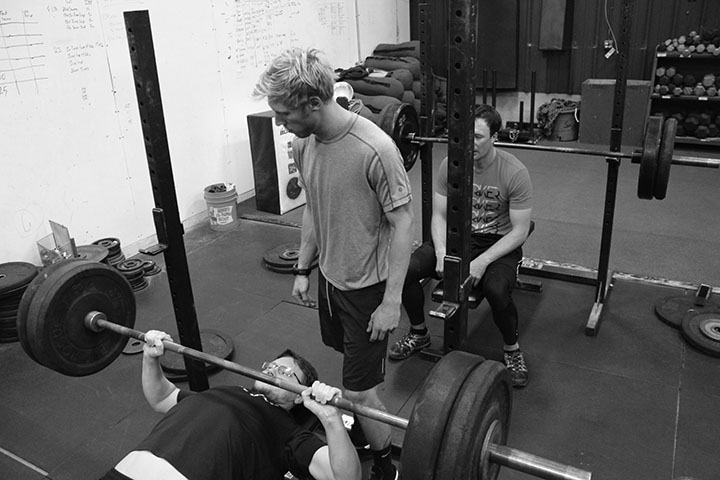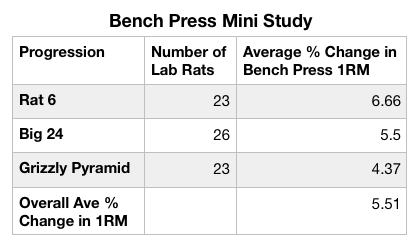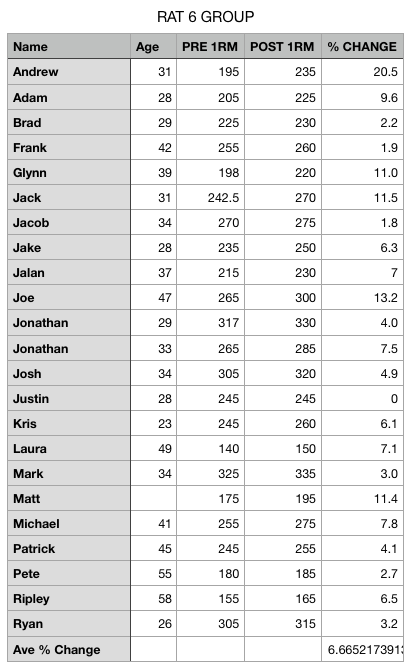
By Rob Shaul, Founder
BLUF
We conducted a 3.5-week Mini-Study using remote lab rats to compare the effectiveness of three MTI strength progressions to increase 1RM (1 Repetition Max) Bench Press Strength.
Specifically, we compared MTI’s Rat 6, Big 24 and Grizzly Pyramid strength progressions.
RESULTS
All three groups saw an average increase in Bench Press 1RM, and the improvement was similar, with the Rat 6 Progression Group narrowly achieving a higher average improvement than the Big 24 and Grizzly Pyramid groups.
See the chart below:

BACKGROUND
MTI’s strength and conditioning research is focused on delivering actionable results to improve mission-direct program design.
The aim of this study was to compare the effectiveness of three different MTI strength progressions: (1) Rat 6; (2) Big 24 and (3) Grizzly Pyramid to increase Bench Press 1RM strength.
From a programming perspective, identifying the most effective strength progression can help focus programming decisions when improving bench press 1RM is a key focus of the program design.
MINI-STUDY DESIGN/DEPLOYMENT
A 3.5-week cycle was designed to test the study questions above, and MTI advertised for Lab Rats via our weekly newsletter, Beta, which has 30,000+ weekly subscribers.
Lab Rat volunteers were randomly divided into three groups, Rat 6, Big 24 and Grizzly Pyramid, and given access to the individual group programming. All Groups began their cycles with a Monday 1RM Bench Press Assessment, which was repeated after three weeks of two-day/week training using the appropriate progression.
The Study was completed in the November – December, 2019 time frame, and the study subjects self-reported their pre and post cycle assessment results.
Each Group completed a total of 7 Bench Press circuits on top of their regular programming. These included the two pre and post-study 1RM assessments.
The study was designed to complement the athletes’ regular training. We asked participants to avoid all other bench pressing and minimize all other upper body pressing during the study duration.
RESULTS AND DISCUSSION
A total of 72 individuals completed the study, 23 each in the Rat 6 and Grizzly Pyramid Group, and 26 in the Big 24 Group. Below are the individual lab rat results.



The Rat 6 Group narrowly saw a higher improvement in Bench Press 1RM Results (6.66%) over the Big 24 (5.5%) and Grizzly Pyramid (4.37%) groups.
However, the results were so close it would be inaccurate to declare the Rat 6 progression as the clear winner.
Study design elements which could have impacted these results could include is it’s relatively short duration (3.5 weeks), and how other training may have impacted bench press performance.
By design, this study didn’t dictate the athlete’s full training regimen during the study period as we wanted to test the ability to study a focused fitness attribute change without dictating complete programming. This was done to encourage lab rat participation and decrease attrition.
NEXT STEPS
We were somewhat disappointed by the study results as we hoped to find a clear progression winner. In programming reality, we frequently rotate through strength progressions to keep the athlete from accommodating and simply add variety to training.
Given the similar results from these three progressions, at least for bench press programming, we see no reason not to continue strength progression rotation.
Next steps could include conducting the same study, but using a lower body exercise – back squat for example, or re-doing the same study but having athletes train the progression 3 times a week, vice two.
Much appreciation to the remote “Lab Rats” who participated in this study. Our remote lab rat program allows us to test more programming, more frequently, and thus further accelerate MTI’s programming evolution and improvement.
Comment below or send your questions/feedback to rob@mtntactical.com
